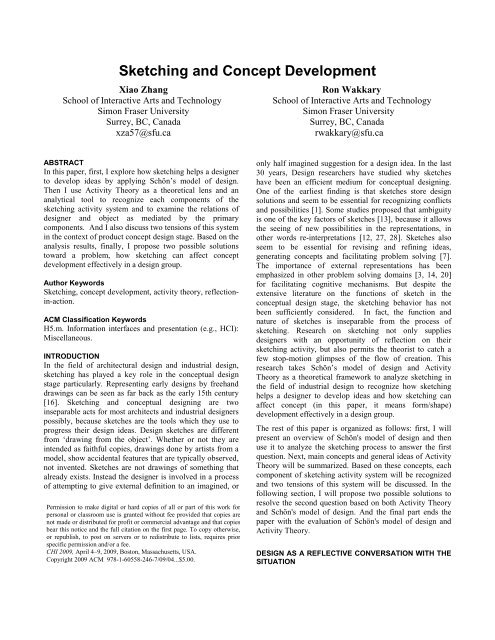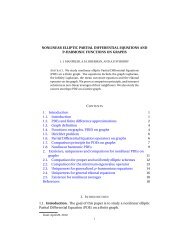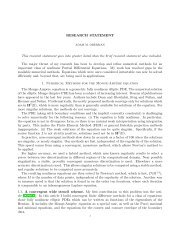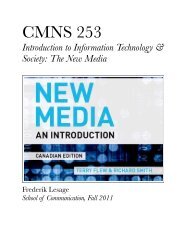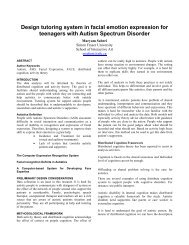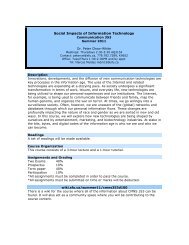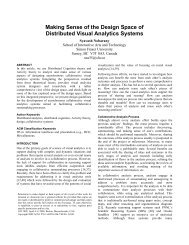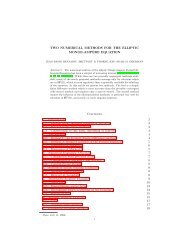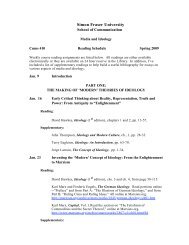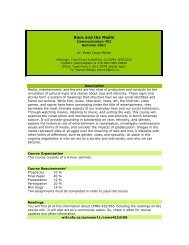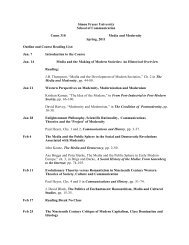iat832_final_paper - SFU Wiki - Simon Fraser University
iat832_final_paper - SFU Wiki - Simon Fraser University
iat832_final_paper - SFU Wiki - Simon Fraser University
You also want an ePaper? Increase the reach of your titles
YUMPU automatically turns print PDFs into web optimized ePapers that Google loves.
Sketching and Concept Development<br />
Xiao Zhang<br />
School of Interactive Arts and Technology<br />
<strong>Simon</strong> <strong>Fraser</strong> <strong>University</strong><br />
Surrey, BC, Canada<br />
xza57@sfu.ca<br />
Ron Wakkary<br />
School of Interactive Arts and Technology<br />
<strong>Simon</strong> <strong>Fraser</strong> <strong>University</strong><br />
Surrey, BC, Canada<br />
rwakkary@sfu.ca<br />
ABSTRACT<br />
In this <strong>paper</strong>, first, I explore how sketching helps a designer<br />
to develop ideas by applying Schön’s model of design.<br />
Then I use Activity Theory as a theoretical lens and an<br />
analytical tool to recognize each components of the<br />
sketching activity system and to examine the relations of<br />
designer and object as mediated by the primary<br />
components. And I also discuss two tensions of this system<br />
in the context of product concept design stage. Based on the<br />
analysis results, <strong>final</strong>ly, I propose two possible solutions<br />
toward a problem, how sketching can affect concept<br />
development effectively in a design group.<br />
Author Keywords<br />
Sketching, concept development, activity theory, reflectionin-action.<br />
ACM Classification Keywords<br />
H5.m. Information interfaces and presentation (e.g., HCI):<br />
Miscellaneous.<br />
INTRODUCTION<br />
In the field of architectural design and industrial design,<br />
sketching has played a key role in the conceptual design<br />
stage particularly. Representing early designs by freehand<br />
drawings can be seen as far back as the early 15th century<br />
[16]. Sketching and conceptual designing are two<br />
inseparable acts for most architects and industrial designers<br />
possibly, because sketches are the tools which they use to<br />
progress their design ideas. Design sketches are different<br />
from ‘drawing from the object’. Whether or not they are<br />
intended as faithful copies, drawings done by artists from a<br />
model, show accidental features that are typically observed,<br />
not invented. Sketches are not drawings of something that<br />
already exists. Instead the designer is involved in a process<br />
of attempting to give external definition to an imagined, or<br />
Permission to make digital or hard copies of all or part of this work for<br />
personal or classroom use is granted without fee provided that copies are<br />
not made or distributed for profit or commercial advantage and that copies<br />
bear this notice and the full citation on the first page. To copy otherwise,<br />
or republish, to post on servers or to redistribute to lists, requires prior<br />
specific permission and/or a fee.<br />
CHI 2009, April 4–9, 2009, Boston, Massachusetts, USA.<br />
Copyright 2009 ACM 978-1-60558-246-7/09/04...$5.00.<br />
only half imagined suggestion for a design idea. In the last<br />
30 years, Design researchers have studied why sketches<br />
have been an efficient medium for conceptual designing.<br />
One of the earliest finding is that sketches store design<br />
solutions and seem to be essential for recognizing conflicts<br />
and possibilities [1]. Some studies proposed that ambiguity<br />
is one of the key factors of sketches [13], because it allows<br />
the seeing of new possibilities in the representations, in<br />
other words re-interpretations [12, 27, 28]. Sketches also<br />
seem to be essential for revising and refining ideas,<br />
generating concepts and facilitating problem solving [7].<br />
The importance of external representations has been<br />
emphasized in other problem solving domains [3, 14, 20]<br />
for facilitating cognitive mechanisms. But despite the<br />
extensive literature on the functions of sketch in the<br />
conceptual design stage, the sketching behavior has not<br />
been sufficiently considered. In fact, the function and<br />
nature of sketches is inseparable from the process of<br />
sketching. Research on sketching not only supplies<br />
designers with an opportunity of reflection on their<br />
sketching activity, but also permits the theorist to catch a<br />
few stop-motion glimpses of the flow of creation. This<br />
research takes Schön’s model of design and Activity<br />
Theory as a theoretical framework to analyze sketching in<br />
the field of industrial design to recognize how sketching<br />
helps a designer to develop ideas and how sketching can<br />
affect concept (in this <strong>paper</strong>, it means form/shape)<br />
development effectively in a design group.<br />
The rest of this <strong>paper</strong> is organized as follows: first, I will<br />
present an overview of Schön's model of design and then<br />
use it to analyze the sketching process to answer the first<br />
question. Next, main concepts and general ideas of Activity<br />
Theory will be summarized. Based on these concepts, each<br />
component of sketching activity system will be recognized<br />
and two tensions of this system will be discussed. In the<br />
following section, I will propose two possible solutions to<br />
resolve the second question based on both Activity Theory<br />
and Schön's model of design. And the <strong>final</strong> part ends the<br />
<strong>paper</strong> with the evaluation of Schön's model of design and<br />
Activity Theory.<br />
DESIGN AS A REFLECTIVE CONVERSATION WITH THE<br />
SITUATION
In his best known book, “The Reflective Practitioner”,<br />
Schön sought an account of the nature of professional<br />
activity based on the common elements of the practices he<br />
had observed. Schön rejected a theory of technical<br />
rationality that distinguishes professionals by the extent of<br />
their “book knowledge” and developed an alternate theory<br />
of the professional as reflective practitioner. A reflective<br />
practitioner is a practitioner whose knowing is not only<br />
rational and cognitive but also embodied in action and for<br />
whom reflection is critical to practice.<br />
Schön discerned three main levels of professional knowing:<br />
• Knowing-in-action — it refers to the kinds of<br />
knowledge we can only reveal in the way we carry<br />
out tasks and approach problems. “The knowing is<br />
in the action. It is revealed by the skilful execution<br />
of the performance – we are characteristically<br />
unable to make it verbally explicit [26].”<br />
• Reflection-in-action — The examination, analysis and<br />
experimentation needed during the process addressing<br />
singular situations; often making the criteria and<br />
knowledge of action explicit and moreover often shifting<br />
from problem solution to problem formulation.<br />
• Reflection-on-action — the retrospective<br />
contemplation of practice undertaken in order to<br />
uncover the knowledge used in practical situations,<br />
by analyzing and interpreting the information<br />
recalled.<br />
Schön also sought a way to define a design process that was<br />
common to the many professional fields of design and took<br />
special interest in how this process may be learned. He<br />
described that there was a great deal of complexity in the<br />
process of design, because the totality of an artifact, system,<br />
or situation includes many elements: materials, a sense of<br />
purposes and constraints as the designer sees them, and the<br />
designer's sense of the people who will eventually use the<br />
artifact resulting from the design process. Also, often, the<br />
thing a designer makes initially is a representation, a plan, a<br />
program, or an image to be constructed by other people.<br />
Many of the relevant variables cannot be represented in a<br />
model; this limitation makes the design process inherently<br />
complex. In addition, the design process is complex in the<br />
specific sense that, whenever a designer makes a move,<br />
he/she gets results that are not just the ones that he/she<br />
intend. That is, he/she cannot make a move that has only<br />
the consequences that he/she intends. And any move has<br />
side effects. “When this happens, the designer may take<br />
account of the unintended changes he has made in the<br />
situation by forming new appreciations and understandings<br />
and by making new moves. He shapes the situation, in<br />
accordance with his initial appreciation of it, the situation<br />
“talks back”, and he responds to the situation's back-talk<br />
[26].” In order to illustrate this complicated process, Schön<br />
used an example of architectural designing in a design<br />
studio, presented audio-taped protocols from teachinglearning<br />
sessions and studied the way that the instructor<br />
made suggestions about a student's design as he gestured<br />
and drew on a sheet of tracing <strong>paper</strong> over her work. Schön<br />
described the instructor’s design behavior, the ensuing<br />
inquiry, as a global experiment and a reflection-in-action<br />
process. So the whole process of the instructor’s design<br />
behavior has been beautifully and famously described as<br />
“design as a reflective conversation with the situation [26]”.<br />
And this process can be separated into four steps which<br />
happen smoothly: naming the relevant factors in the<br />
situation, framing a problem in a certain way, making<br />
moves toward a solution and evaluating those moves. The<br />
designer functions as both a creator developing a solution<br />
and an experimenter trying to understand the situation he is<br />
creating in this process. As such, Schön’s model accounts<br />
for the dynamic, cyclic, unfolding and unpredictably nature<br />
of design. In fact, this model is based on two arguments.<br />
First, framing a problem consists of ‘knowing in action’<br />
(i.e. design experience, design knowledge, skills and<br />
judgments), which cannot be accounted for in mere<br />
scientific terms. Second, knowing in action helps the<br />
designer to construct a new way of setting the problem – a<br />
new frame, which he imposes on the situation.<br />
How Sketching Helps A Designer Develop Ideas<br />
Schön viewed design as a reflective conversation with the<br />
situation, where the designer interacted with the situation in<br />
the reflection-in-action process being distinguished from<br />
reflection-on-action. Just as the teaching-learning example<br />
Schön gave, the sketching process in the concept design<br />
stage of industrial design is also a reflection-in-action<br />
process in which a designer reflects both on the shape<br />
he/she is representing through his/her drawing and on<br />
his/her previous way of thinking about the situation in the<br />
sketch. A reflective conversation happens between the<br />
designer and his/her sketch, the shapes he/she draws on<br />
<strong>paper</strong>. That is, when the emerging and changing shape<br />
“talks back” to a designer, he/she simultaneously responds<br />
to the shape by transforming the shape in his/her mind and<br />
representing the changed shape through his/her hand and<br />
pen, such as adding a circle or thickening a line. In fact, in<br />
the context of sketching, shape’s “talks back” is designer’s<br />
recognition of this shape. During the recognition process,<br />
designers selectively recognize certain shapes that they can<br />
see by concentrating their visual searchlight. So the<br />
recognized shapes are not identical copies of the shapes on<br />
the <strong>paper</strong>. The conversation between a designer and his/her<br />
sketch is illustrated in Figure1.<br />
Based on the analysis above, I describe sketching activity as<br />
a “recognizing--- transforming --- representing” process. By<br />
applying the recognizing capacity, designers could see<br />
meaningful shapes from ambiguous sketches. Then, in the<br />
transformation process, the recognized shapes are<br />
transformed not only to satisfy design functions [27] but<br />
also to consider the previous shapes [13]. In the following<br />
process, the transformed shapes are depicted on the <strong>paper</strong><br />
through designers moving a pen. In the whole process,
shapes are continually changed and thus the design ideas<br />
are developed. Therefore, from the microscopic perspective,<br />
sketching process is illustrated in Figure 2.<br />
Figure 1. Reflective conversation between a designer and<br />
his sketch<br />
After our design team’s research which considers the kiosk<br />
design from different perspectives, like Accessibility and<br />
Ergonomics, we determined three design ideas: Fixed Wall<br />
Mounted kiosk, Adjustable kiosk and Sculpture –like kiosk.<br />
As for the idea of Sculpture –like kiosk, I had two forms in<br />
my mind initially. As illustrated in Figure 5, although they<br />
are similar to some extents, they can be developed and<br />
transformed into other shapes. Moreover, during the<br />
sketching process, some shapes are generated by combining<br />
more than one previous concept, like concept f, g, m, i, k<br />
(see Figure 4). Therefore, various concepts for one design<br />
idea come from:<br />
• Lateral transformations: movement from one<br />
concept to a slightly different one.<br />
• Vertical transformations: movement from one<br />
concept to a more detailed and exacting version of<br />
the same concept.<br />
• Composite transformations: movement from more<br />
than one concept to a different one.<br />
Figure 2. Figure captions should be centered and<br />
placed below the figure<br />
• Design image (ID): an imagined, or only half<br />
imagined shape for a design idea.<br />
• Sketch image (IS): the shapes which are depicted<br />
on the <strong>paper</strong> through designers moving a pen.<br />
• Recognized image (IR): the shapes in designers’<br />
mind which are recognized from IS.<br />
• Transformed image (IT): the shapes in designers’<br />
mind which are transformed IR by additions,<br />
deletions and modifications.<br />
Figure 3. One cycle in sketching process<br />
In essence, these four kinds of images are different from<br />
each other. Because first of all the image (IR) of the sketch<br />
that designer have recognized through their visual<br />
perception is not what the sketch (IS) originally intends to<br />
present; Then, designers design and redesign in their mind<br />
to generate various design concepts (IT); And most<br />
importantly, in the actual representing phase, due to lack of<br />
drawing skills, designers may not draw the shapes like their<br />
wishes, which may lead to a completely new image。<br />
From the analysis above, sketching, which begins with an<br />
imagined, or only half imagined shape in a designer’s mind,<br />
is a dynamic, experimental, unpredictable and iterated<br />
process until the designer is satisfied with the <strong>final</strong> shapes.<br />
And each cycle has three processes (see Figure 3). However,<br />
in reality (see Figure 4), the situation of the sketching<br />
process is more complicated than the model (see Figure 2),<br />
because for one design idea, a designer may have several<br />
design images in his/her mind. Take a design project as an<br />
example, an information kiosk design for an art museum.<br />
Figure 4. One design project of mine
Figure 5. Two concepts from the same idea<br />
Based on the designing ability of designers, their capacity<br />
of recognition, transformation and representation will also<br />
be different (see Figure 6). Liu [22] proposed that people<br />
from different backgrounds would notice different levels of<br />
shapes; however, only people who have certain design<br />
ability would recognize subshapes, which are hidden in<br />
shapes. For instance in Figure 7, not all designers pay<br />
attention to the three subshapes: U shape on the top surface;<br />
the top surface is convex; the front surface is not flat. In<br />
comparison, the transformation process is determined by<br />
design experience and the associating capability of<br />
designers. And a designer’s drawing skill affects the<br />
representation outcome. Thus, different designers who see<br />
the same shape will produce different quantity and quality<br />
distinct sketches.<br />
Figure 6.<br />
Figure 7. Recognizing subshapes<br />
ACTIVITY THEORY<br />
Activity Theory is a philosophical and cross disciplinary<br />
framework for the study of different forms of human<br />
practices as development progresses, with both individual<br />
and social levels interlinked at the same time [17]. The term<br />
“Activity Theory” emerged between 1920 and 1930, in the<br />
Soviet Historic-Cultural School of Psychology [18, 24].<br />
Activity Theory has evolved through three generations of<br />
research. When discussing activity, activity theorists are not<br />
simply concerned with “doing” as a disembodied action but<br />
are referring to “doing in order to transform something”,<br />
with the focus on the contextualized activity of the system<br />
as a whole [9, 10, 19]. Activity Theory is formed by a set of<br />
principles that constitutes a general conceptual system. The<br />
basic principles of Activity Theory are [18, 24]:<br />
• Principles of the unit between activity and<br />
consciousness. It is considered the fundamental<br />
principle of Activity Theory, where activity and<br />
consciousness are treated in an integrated way.<br />
The consciousness means the human mind like a<br />
whole, and activity means the human interaction<br />
with its objective reality. This principle states that<br />
the human mind emerges and exists like a special<br />
component of the human interaction with its<br />
environment [18]. The mind is a special organ that<br />
appears in the evolution process to help organisms<br />
to survive. So, it can be analyzed and understood<br />
only within the human activity context.<br />
• Principle of the object orientation. This principle<br />
focuses on the approach of Activity Theory for the<br />
environment where the human being interacts.<br />
Human beings leave in an environment that is<br />
very important for them. This environment<br />
consists of entities that combine all kinds of<br />
objective features, including those culturally<br />
determined, which influence the ways persons act<br />
over those entities.<br />
• Principles of the hierarchical structure of activity.<br />
Activity Theory differentiates the human<br />
procedures in several levels (activity, action and<br />
operation), taking into account the objectives to<br />
which these procedures are oriented. The<br />
importance of that distinction is determined by the<br />
ecological attitude from Activity Theory. In a real<br />
situation, this distinction is frequently necessary<br />
to preview the human behavior. So, this<br />
distinction is very important to make the<br />
differentiation among motives, goals and<br />
conditions that are associated.<br />
• Principle of the internalization-externalization.<br />
This principle describes the basic mechanisms<br />
about the mental processes source. It states that<br />
mental processes are derived from external actions<br />
through the way of the internalization [18].<br />
Internalization is the information absorption<br />
process (in several ways) achieved by human<br />
mind, which derives from the contact with the<br />
environment where the person is located. The<br />
externalization is the process contraire to<br />
internalization, manifested through acts, in such a<br />
way they can be verified and fixed, if necessary.<br />
• Principle of the mediation. The human activity is<br />
mediated by several tools, both external and
internal. The tools are “vehicles” of the social<br />
experience and cultural knowledge.<br />
• Principle of the development. According to<br />
Activity Theory, to understand a phenomenon<br />
means to know how it is developed by itself until<br />
its current shape, because it changes by the time.<br />
Understanding these changes can help to<br />
understanding its current state.<br />
These principles are not isolated ideas, they are closely<br />
connected. The nature of Activity Theory is manifested in<br />
this set of principles.<br />
Figure 8 portrays a pictorial representation of a generic<br />
activity system as conceptualized by Engeström [9, 10].<br />
The subject is the agent that acts over an object. Object can<br />
be raw materials, conceptual understandings, or even<br />
problem spaces, “at which the activity is directed and which<br />
is molded or transformed into outcomes with the help of<br />
physical and symbolic, external and internal tools [10]”.<br />
The community of a system refers to those individuals,<br />
groups, or both who share the same general objects, and are<br />
defined by their division of labor and shared norms and<br />
expectations. Specifically, divisions of labor can run<br />
horizontally as tasks are spread across members of the<br />
community with equal status, and vertically as tasks are<br />
distributed up and down divisions of power. Last, activity<br />
systems are somewhat constrained by the formal, informal,<br />
and technical rules, norms, and conventions of the<br />
community.<br />
The components of activity systems are not static<br />
components existing in isolation from each other but are<br />
dynamic and continuously interact with the other<br />
components through which they define the activity system<br />
as a whole. From an Activity Theory perspective, an<br />
examination of any phenomenon must consider the<br />
dynamics among all these components. In addition to the<br />
interactions of an activity system of a particular time and<br />
space, it is important to note that an activity system is made<br />
up of nested activities and actions all of which could be<br />
conceived of as separate activity systems or other instances<br />
of the same system depending on one’s perspective. For<br />
example, although the computer may serve as a tool in a<br />
current action, at an earlier time this computer may have<br />
been an object or an outcome in what may be conceived as<br />
a previous action of the same activity system or even as a<br />
different activity system.<br />
A focus of Activity Theory is on how participants transform<br />
objects, and how the various system components mediate<br />
this transformation. With respect to the role of computers,<br />
for example, activity theorists are concerned with how these<br />
tools mediate the relations between subject and object.<br />
Therefore, it is not simply the human–computer (subject–<br />
tool) interaction that is fundamental to understand, but the<br />
subject–object interactions as mediated by the computer<br />
that become crucial [19]. This perspective expands the unit<br />
of analysis from the mind of the individual (as in traditional<br />
cognitive research) or from the human–computer<br />
interaction (as in traditional human–computer interaction<br />
research) [5, 6], to the entire activity system [4]. Activity<br />
systems are characterized by their internal contradictions [9,<br />
10, 21]. These contradictions are best understood as<br />
tensions among the components of the activity system.<br />
Tensions are critical to understanding what motivates<br />
particular actions and in understanding the evolution of a<br />
system more generally.<br />
In summary, an examination of an activity system must<br />
address all these components, as well as the inherent<br />
tensions, as a unified system.<br />
Figure 8. The basic structure of human activity<br />
How Sketching Can Affect Concept Development<br />
Effectively in a Design Group<br />
In this section, first, I will present an overview of concept<br />
design stage in industrial design which will provide me a<br />
background to consider the problem, how sketching can<br />
affect the concept development effectively in a design<br />
group. Second, I will use activity theory as my theoretical<br />
lens and analytical tool to recognize each components of a<br />
sketching activity system and to examine the relations of<br />
designer and object as mediated by the primary components.<br />
Engeström’s triangle [9] is used to define the component<br />
structure of sketching activity based on different design<br />
stage. Then, according to my own design experience and<br />
some research on collaborative design, two inherent<br />
tensions in the sketching activity system will be identified.<br />
Finally, I will propose solutions to resolved the tensions and<br />
thus give suggestions towards the problem.<br />
An Overview of Concept Design Stage in Industrial Design<br />
New Industrial Product Development Process is a series of<br />
phases that projects generally take in progressing from<br />
initial product idea generation through stable production.<br />
The first two stages are idea generation and concept design.<br />
Idea generation activity lays the groundwork for entry into<br />
the Product Development Process. Prior to starting the<br />
concept design phase, information on market development<br />
(competitive offerings, etc.), customer satisfaction<br />
feedback, technology development and business strategy is<br />
helpful for generating ideas for a new product. Wherever a<br />
new product idea is generated in the ideation process, the<br />
product concept design phase begins when an idea or new
product innovation is documented and initially reviewed by<br />
management. If management commits to supporting the<br />
definition and evaluation of the product ideas for possible<br />
funding, it enters the product concept design phase. In the<br />
concept design stage, several industrial designers work<br />
collectively with other participants who may come from<br />
management, marking, engineer, the software department<br />
as well as stakeholders or users. The staff structure of<br />
concept design group varies, according to different project<br />
and different company. The main goal of this phrase is<br />
developing product ideas into different concepts----in other<br />
words, forms. And concepts are often showed through<br />
sketches, because sketching is a low-cost, fast and flexible<br />
way. As is shown in Figure 9, concept design stage is an<br />
iterative, repeated divergent and convergent process [23]. In<br />
a divergent step, a range of concepts is generated, followed<br />
by a convergent step in which evaluation and selection of<br />
these are made. Along with the increase of the iterative<br />
times, detailed concepts will be provided.<br />
Figure 11. Structure of sketching activity<br />
Subject: people who involve in the sketching activity in the<br />
concept design stage. Often, more than one designer work<br />
on sketching, because a principal aim of conceptual design<br />
is to generate promising concepts. To achieve this aim,<br />
generating a wide range of concepts is important, so that<br />
valuable concepts are not overlooked.<br />
Figure 9. Concept design stage which is a repeated divergent<br />
and convergent process<br />
Activity Theory as Analytical Tool<br />
According to the overview of concept design stage, there<br />
are three main activities: sketching, evaluating and<br />
choosing. They are driven by different motives and are<br />
realized through a sequence of actions. But this <strong>paper</strong> only<br />
develops the systemic model of sketching. Figure 10 is the<br />
sketching activity system at the first design stage and<br />
sketching activity is decomposed into actions: recognizing,<br />
transforming and representing (see Figure 11).<br />
Object: ideas which generated at the first phase of the new<br />
industrial product development process.<br />
Tool: drawing tools and design knowledge which help<br />
designers to transform design ideas into concepts.<br />
In industrial design sketches, the most frequently used<br />
drawing tools are pencil, pen and marker.<br />
• Pencil includes regular pencil and colored pencil.<br />
This kind of tool allows user to draw smooth, fluid<br />
and soft flowing lines. The richness of layers of<br />
lines brings the sketch lifelikeness and reality.<br />
Designers can adjust the angle, pressure and<br />
number of lines to control the thickness, tone and<br />
opacity of their sketches. In addition, Pencil<br />
drawings can be easily erased and corrected which<br />
would be appropriate for drawing curves and<br />
products that have smooth surfaces (see Figure<br />
12).<br />
Figure 12. Pencil as a tool<br />
Figure 10.<br />
• Pen includes pen, signature pen and ball-point pen.<br />
These tools can draw succinct and sprightly thin<br />
lines that have strong contrast and expressiveness,
ut they are hard to modify. Pens are good for<br />
depicting details and more delicate sketches and<br />
are usually adopting the method of single line<br />
tracing. Final design sketches are mostly pen<br />
sketches because they are high contrasted, hardly<br />
blurred and long lasting (see Figure 13).<br />
Figure 13. Pen and ball-point pen as tools<br />
• Markers are usually used along with pen or pencil.<br />
They have unique colors, various shapes and<br />
thickness of strokes that can change the density of<br />
lines and bring the sketch to life. Different lines<br />
can be drew depend on different pressure, speed,<br />
tone, dryness, thickness and density of the use of<br />
strokes and they can quickly express shapes,<br />
surfaces, textures and colors of the product (see<br />
Figure 14).<br />
Outcome:sketches which come from object, design ideas.<br />
Sketch is different from drawing. Industrial design sketch<br />
has some distinct characteristics which are used to help<br />
designers to express their ideas about the form. An<br />
examination by a research team of a collection of<br />
automotive sketches revealed these characteristics. The<br />
study showed that there were a number of different ways in<br />
which lines were used. They tend to be of the following<br />
types [29] (see Figure 15):<br />
• Form lines: these are typically the lines along shutlines,<br />
or car body panel edges, which are the key<br />
form descriptors. They are assumed to be of<br />
primary importance in delineating the shape that<br />
the designer intends for the design.<br />
• Crown lines: these are not ‘real’ lines in the design<br />
but indicate the crown of a curve, or extent of a<br />
contour.<br />
• Area lines: these are lines which simply define an<br />
area. This may be a physically separate component<br />
(eg; a numberplate) or a cartoon-like depiction of<br />
the edge of a shadow.<br />
The other key components of sketches are shading and<br />
colour. Both are used less often in initial concept sketches,<br />
which may consist simply of lines. In the same study<br />
mentioned above, the designers observed rendered almost<br />
exclusively in lines when in the early stages of concept<br />
development. When shade is used, it is intended to enhance<br />
the three dimensional definition of the form, usually at later<br />
concept design stage. Interestingly, the students observed in<br />
this study made much greater use of shading and colour<br />
than professional designers. Possibly the fact that their<br />
sketches were intended to communicate with their assessors<br />
has something to do with this, or it may be simply that the<br />
professionals’ greater fluency allows them to suggest form<br />
quickly without resorting to shading.<br />
Figure 14. Marker and pen as tools<br />
• Product concept design requires many design<br />
factors to be considered simultaneously and<br />
involves several fields of knowledge. It mainly<br />
includes designers’ experiences about the form,<br />
structure, craftsmanship, materials and color of the<br />
industrial product as well as their skills of design<br />
representation and the knowledge of background<br />
information of the product they are designing.<br />
Figure 15. Form line, area line and crown line<br />
Community:industrial designers and any individual who<br />
has a legitimate say in the process, whose words, proposals,<br />
claims and supplications matter and contribute to the <strong>final</strong><br />
form of the product I consider a participant in community.
The core group in concept design stage is of a particular<br />
sort. These participants are, for the most part, members of a<br />
firm – a corporate entity whose purpose is production for<br />
profit. They share a common object, namely to transform<br />
design ideas into a concept which will contribute to a<br />
product of quality which is related to their and the firm’s<br />
survival. Yet, at the same time, Participants from different<br />
domains work in a system; they have different focuses,<br />
experiences and cultural backgrounds which can lead to<br />
limited understanding of each other. For example,<br />
Engineering professionals use scientific methods to solve<br />
technical problems [25], while industrial designers focus on<br />
social and cultural values of the product, making it difficult<br />
for engineering designers to perceive solutions accurately<br />
[30]. Negotiation and trade-offs are required to bring<br />
participants’ efforts into coherence. So while members of a<br />
collective share a common goal at some level, at another<br />
level their interests will conflict and they strive in<br />
competition. These complex relationships among<br />
participants affect the design ideas transformation process.<br />
Division of Labor : each designer takes in charge of<br />
transforming design ideas into concepts. And other<br />
members in the community help the transformation<br />
between design ideas and concepts by providing useful<br />
information or knowledge.<br />
Rules: rules in sketching system mainly include technical<br />
roles or laws, like accessibility laws; formal and informal<br />
social roles like trust, mutual respect, shared vision,<br />
frequent communication, and flexibility.<br />
Structure of sketching activity: According activity theory,<br />
an activity is oriented by a motive, the actions are oriented<br />
to goals, and the operations oriented to conditions. Only<br />
after an analysis of the current conditions, operations are<br />
executed. Also, sketching activity is a reflection-in-action<br />
process, designers work in a continuously changing<br />
situation. Thus, operations in sketching activity are not<br />
fixed. Figure 11 about the structure of sketching is not<br />
exactly right. It just summarizes some possible operations<br />
when designers are sketching.<br />
Sketching Activity System Development:<br />
Along with the development of sketching system, the<br />
components of this system are dynamic and not static. For<br />
the same designer, Figure 16 shows that sketches which are<br />
generated at the first design stage are the tool of the second<br />
design stage sketching system and concepts in them are the<br />
object.<br />
Figure 16. Sketching activity system development<br />
Tensions between Activity System Elements:<br />
The first tension arises out of collaboration between<br />
designers and other participants in the community who<br />
come from distinct disciplines such as engineering,<br />
business, and sociology. Their different domain knowledge<br />
and value allow them to see the same object from different<br />
perspective. This <strong>paper</strong> focuses the tension between<br />
designers and engineers, who often collaborate in the<br />
concept design stage. Although they both contribute to new<br />
product’s concept development, industrial designers have a<br />
bias towards appearance and user-interface; whereas<br />
engineers focus on functionality and manufacture to ensure<br />
that the product satisfies the design specification and<br />
manufacturing requirements [15]. Their Working<br />
Approaches are also different. Industrial designers<br />
generally adopt 3D sketches as representations of concepts.<br />
For them, such kind of drawing enhances discussions and<br />
improves spatial and perceptual assessment. But engineers<br />
apply scientific knowledge to ensure that products<br />
optimally meet design specifications with representations in<br />
the form of engineering drawings (see Figure 17) that show<br />
requirements based on quality, performance and cost [11,<br />
8], even when they use free hand drawing to develop<br />
concepts, they love to illustrate the concept in the form of<br />
engineering drawings (see Figure 18). So differences in the<br />
use of tools and methods have made collaboration between<br />
groups difficult [2]. As a participant in a machine tool<br />
design project, I felt this tension between designers and<br />
engineers deeply.
in a design group, novice designers often feel frustrated and<br />
thus affect the collaboration, the quantity and quality of<br />
concepts.<br />
Figure 17. Engineering drawing<br />
The analyses of these two tensions are not exhaustive and<br />
there must be other tensions in sketching activity system.<br />
But these two tensions often appear in design groups and<br />
affect concept development obviously. In other word, the<br />
transformation process between object and outcomes of<br />
sketching activity system is influenced by these two<br />
tensions.<br />
According to all the analysis of sketching behavior above,<br />
for the first one tension, I argue that when a designer<br />
communicates with an engineer, he/she should use both 3D<br />
sketch and engineering drawing to represent his concept, as<br />
shown in figure 19. This combination representing method<br />
not only allows designers to communicate with engineers<br />
conveniently, but can also help designers clarify their<br />
thoughts in order to optimize the <strong>final</strong> outcome.<br />
Figure 18. Free hand engineering drawing<br />
Tension within Activity System Elements:<br />
The second tension which is caused by difference of design<br />
ability exists in designers, each subject of the sketching<br />
system. Many design study have demonstrated a difference<br />
of design ability among designers in a product design task,<br />
especially between an expert and a novice designer,<br />
because of their different design experience, background,<br />
problem decomposition strategy and so on. One study [29]<br />
has been conducted in an automotive design group,<br />
including six MA automotive design students and six<br />
professional designers who work at the Ford design studio<br />
in Dunton. They were asked to produce a quick concept<br />
sketch; no brief was given as to the type of vehicle design<br />
to be undertaken. They also had freedom of viewing angle,<br />
sketching tools, colours and materials. The results showed<br />
that there were some obvious differences between the two<br />
groups. Professional designers produced many more<br />
sketches in many more views. This demonstrated both a<br />
greater understanding of 3D, and a better using the sketches<br />
to facilitate problem solving and creative effort. Therefore,<br />
Figure 19. 3D sketch and engineering drawing simultaneous to<br />
represent concept<br />
For the second tension, I propose a concept-shared model.<br />
It is illustrated in figure 20. It means after the first design<br />
stage, all designers share the concepts generated in the<br />
previous stage. So if a designer doesn’t have more ideas<br />
about the shapes of the product, other designers’ concepts<br />
can inspire him. This method can improve the quality and<br />
quantity of concepts theoretically, because designers<br />
recognize different shapes when they see the same image.<br />
Figure 21 presents the difference of sketch quantity<br />
between a concept-shared model and concept-independent<br />
model. The concept-independent model, which is used<br />
extensively in the industrial design field, indicates that each<br />
designer only uses his/her concepts through all the concept<br />
design stage.<br />
In summary, combination representing method and<br />
concept-shared model which arise from partially changed<br />
sketching activity can be considered as possible solution to
the question, how sketching can affect concept development<br />
effectively in a design group.<br />
Figure 20. Concept-shared model in concept design process<br />
and recognize a phenomenon, sketching activity, with<br />
which I am familiar.<br />
Although Schön emphasized the importance of ‘reflectionin-action’<br />
in design process, not in all design situation,<br />
designers exhibit a reflection-in-action. Only in the<br />
situation, when designers can work smoothly without<br />
stopping, they are reflecting in action, both on the<br />
phenomena they are representing through their drawing and<br />
on their previous way of thinking about the design problem.<br />
In some design situation, on the other hand, when the<br />
designer pauses to think back over what he/she has done in<br />
a project, exploring the understanding that he/she has<br />
brought to the handling of the task. He/she may, for<br />
example, construct a new theory of the case, reframing the<br />
problematic design situation in such a way as to redefine,<br />
interactively, both means and ends, he/she exhibits a<br />
reflection on action. And I also think that there should be a<br />
reflection-before-action when we plan put before we act<br />
what we want to do.<br />
For activity theory, just like Nardi said “Activity Theory is<br />
a powerful and clarifying descriptive tool rather than a<br />
strongly predictive theory[24]”, Activity Theory provides<br />
us with a powerful theoretical lens to recognize each<br />
component of an activity system and their structure clearly,<br />
especially when we face a more complicated situation. But,<br />
as an analytical tool, it only provides us a general<br />
framework, rather than concrete ways or steps to analyze a<br />
specific activity. Second, it emphasizes contradictions in an<br />
activity system, so it helps us to find out problems in a<br />
system instead of giving solutions to existing problems.<br />
Third, it provides us with a nondualist theory for describing<br />
the inseparability of activity and the environment in which<br />
it happens. From this perspective, context is neither simply<br />
a container nor a situationally created experiential space but<br />
is an entire activity system, integrating the participant, the<br />
object, the tools (and even communities and their rules and<br />
divisions of labor) into a unified whole [10]. Forth, both an<br />
activity system and its components are dynamic and are not<br />
static. But I found few people pay attention to this<br />
characteristic in our discussion.<br />
In summary, these two theories are really helpful for me.<br />
Not only am I exposed to new concepts, but also I start to<br />
consider phenomena from a new perspective.<br />
CONCLUTION<br />
Figure 21. Two design models comparing<br />
The idea of this <strong>paper</strong> is inspired by two concepts:<br />
“reflection-on-action” and “tension” in an activity system.<br />
“Reflection-on-action”, as the name implies, tells me that a<br />
designer should think about the design process after the<br />
fact. “Tension” makes me to consider the contradiction in<br />
an activity system. Both Schön’s model of design and<br />
Activity Theory give me distinctive perspectives to rethink<br />
As for the study of sketching behavior, it is useful for CAID<br />
(Computer Aided Industrial Design) system design,<br />
especially when the system will support concept<br />
development. The concept-shared model provides an idea<br />
for developing a Collaborative Sketching Technique which<br />
is a hot point of research in CAID.<br />
ACKNOWLEDGMENTS<br />
Thanks to my professor, Ron Wakkary, for providing the<br />
theories and his difficult concepts explanation in the class.
And also thank my classmates who were in the team<br />
discussion.<br />
REFERENCES<br />
1. Akin, O. How do architects design in J C Latombe (ed)<br />
Artificial intelligence and pattern recognition in computer<br />
aided design, North Holland, Amsterdam (1978) 65-119.<br />
2. Anon."Closing the Loophole: Bringing together<br />
industrial design and CAD." Engineering Designer - The<br />
Journal of the Institution of Engineering Designers 28, 3<br />
(2002): 16.<br />
3. Bauer, M. I., Johnson,L. How diagrams can improve<br />
reasoning. Psychological Science 4 (1993) 372-378.<br />
4. Barab, S. A. Commentary: Human-field interaction as<br />
mediated by mobile computers. In T. Koschmann, R.<br />
Hall, & N. (2002). Miyake (Eds.), Computer supported<br />
collaborative learning. Mahwah,NJ: Lawrence Erlbaum<br />
Associates, Inc. 533–538.<br />
5. Carroll, J. M. Interfacing thought: Cognitive aspects of<br />
human-computer interaction. Cambridge, MA: MIT<br />
Press. (1987).<br />
6. Carroll, J. M. Designing interaction: Psychology at the<br />
human-computer interface. Cambridge, MA: Cambridge<br />
<strong>University</strong> Press. (1991).<br />
7. Do, E Yi-L, Gross, MD, Neiman, B and Zimring, C.<br />
Intentions in and relations among design drawings.<br />
Design Studies 21 ,5(2000) 483-503<br />
8. Dumaine, B., "How managers can succeed through<br />
speed", Fortune, No.13 February, (1989), 54-9.<br />
9. Engeström, Y. Learning by expanding. Helsinki:<br />
Orienta-konsultit. (1987).<br />
10. Engeström, Y. Developmental studies of work as a test<br />
bench of activity theory: The case of primary care<br />
medical practice. In S. Chaiklin & J. Lave (Eds.),<br />
Understanding practice: Perspectives on activity and<br />
context. Cambridge, MA: Cambridge <strong>University</strong> Press.<br />
(1993). 64–103.<br />
11. Flurscheim, C. H., Industrial Design in Engineering.<br />
The Design Council. London, (1983).<br />
12. Fish, J and Scrivener, S. Amplifying the mind’s eye:<br />
sketching and visual cognition. Leonardo 23,1 (1990)<br />
117-126.<br />
13. Goel, V. Sketches of thought. MIT Press, Cambridge,<br />
MA (1995).<br />
14. Hegarty, M. Mental animation: inferring motion from<br />
static displays of mechanical systems. Journal of<br />
Experimental Psychology: Language, Memory and<br />
Cognition, 18 (1992) 1084-1102.<br />
15. Hurst, K. Engineering Design Principles. New York,<br />
Arnold Publishers. (1999)<br />
16. Jenkins, D. L., Martin, R. R. ‘The importance of freehand<br />
sketching in conceptual design: automatic sketch<br />
input’. American Society of Mechanical Division, 53<br />
(1993) 115–128.<br />
17. Kuutti, K. Activity Theory as a potential framework for<br />
Human-computer interaction research. In B.A. Nardi,<br />
(ed.), context and consciousness: Activity Theory and<br />
Human-Computer Interaction. Cambridge, MA: MIT<br />
press. (1996).<br />
18. Kaptelinin, V. , Nardi, B. A., “Activity Theory: Basic<br />
Concepts and Applications”, CHI 97 Electronics<br />
Publications: Tutorials, march/1997,<br />
http://www.cwi.nl/~steven/chi97/proceedings/tutorial/b<br />
n.html.<br />
19. Kuutti, K. Activity theory as a potential framework for<br />
human-computer interaction research. In B. Nardi (Ed.),<br />
Context and consciousness: Activity theory and humancomputer<br />
interaction. Cambridge, MA: The MIT Press.<br />
(1996) 92–117.<br />
20. Larkin, J., H., <strong>Simon</strong>, H., A. Why a diagram is<br />
(sometimes) worth ten thousand word. Cognitive<br />
Science 11 (1987), 65-100.<br />
21. Leont’ev, A. The problem of activity in psychology.<br />
Soviet Psychology, 13, 2 (1974) 4–33.<br />
22. Liu, Y. T. Some phenomena if seeing shapes in design.<br />
Design Studies, 16 (1995) 367-407.<br />
23. Liu, Y.C., Bligh, T. Towards an ‘ideal’ approach for<br />
concept generation. Design Studies 24 (2003) 341–355.<br />
24. Nardi, B. A., Context and Consciousness - Activity<br />
Theory and Human-Computer Interaction, MIT Press,<br />
1996.<br />
25. Persson, S., (2002). Industrial Design - Engineering<br />
Design Interaction. Engineering and Industrial Design,<br />
Product and Production Department. Göteborg,<br />
Sweden, Chalmers <strong>University</strong> of Technology.<br />
26. Schon, D. A. The reflective practitioner: how<br />
professionals think in action Basic Books, New York,<br />
(1983).<br />
27. Schon, D., Wiggins, G. Kinds of seeing and their<br />
function in designing. Design Studies, 13, 2 (1992) 135-<br />
156.<br />
28. Suwa, M, Gero, J S and Purcell, T. Unexpected<br />
discoveries and s-inventions of design requirements:
important vehicles for a design process. Design Studies,<br />
21 (2000)539-567.<br />
29. Tovey, M., Porter, S. Sketching, concept development<br />
and automotive design. Design Studies 24 (2003) 135–<br />
153.<br />
30. Warell, A., PhD Thesis: Design Syntactics: A<br />
Functional Approach to Visual Product Form. In<br />
Relational Modes between Industrial Design and<br />
Engineering Design - a Conceptual Model for<br />
Interdisciplinary Design Work. S. Persson and A.<br />
Warell,Göteborg, Sweden, Chalmers <strong>University</strong> of<br />
Technology. (2001).


